SOVIETS SET TO CRUSH NAZIS IN EAST
Moscow, Soviet Union · January 11, 1945
On this date in 1945 the Germans intercepted a Soviet radio transmission that ominously declared, “Everything is ready.” The Soviet offensive on the Eastern Front between the Baltic Sea in the north and the Carpathian Mountains in the south began the next day with an artillery barrage that pulverized German defenses. The offensive developed at breathtaking speed: parts of East Prussia were overwhelmed within ten days, and by January 26, 1945, the Red Army had reached the Gulf of Danzig, thus cutting off East Prussia from the rest of the Reich (see map below). Cracow (Kraków), Poland, the capital of the Nazis’ so-called General Government, fell on January 19, and Warsaw, Poland’s largest city, on January 17. On the same day the Soviets reached the eastern bank of the Oder River above Breslau (Wroclaw), the capital of Upper Silesia and the second-most productive German industrial area after the Ruhr in the western part of Germany. Lodz (Łódź), Poland’s second-largest city, was liberated after token resistance on January 19. Just after January the Soviets halted 90 miles from Berlin to mop up German Army stragglers, resupply their armies, rest their men and machines, and “tidy up” East Prussia. The end of January 1945 saw the Nazi war machine suffer its highest-ever monthly total of casualties—over 450,000—far exceeding the 185,000 who had died in January 1943, the month of the Wehrmacht’s defeat at Stalingrad (present-day Volgograd). Combined January and February casualty figures for the Eastern Front alone exceeded 700,000. Never before had so many Germans been killed (77,000), wounded (334,000), or gone missing (292,000) in so short a time. Adolf Hitler’s New Year message at the top of the month, in which he asserted his faith in ultimate victory, his “unshakeable belief that the hour is near in which victory finally will come,” was erased from memory on the morning of February 3, 1945, when the Americans sent more than 900 bombers to attack the Nazi capital, Berlin, with high-explosive and incendiary bombs, destroying the government district, bringing trains and streetcars to a halt, and causing fires to rage everywhere. Close to 2,900 people were killed in the air attack, which left more than 100,000 Berliners homeless. Despair gripped German citizens as they awaited the end of the Third Reich.
![]()
[amazon_carousel widget_type=”ASINList” width=”600″ height=”200″ title=”Recommended Reading” market_place=”US” shuffle_products=”False” show_border=”False” asin=”1844159353,0060540370,1848843801,0393322521,0760338981,1844159779,0465028551,0143122134,0142002801,0394757777″ /]
Soviet March on Nazis’ Reich Capital and Its Destruction, 1945
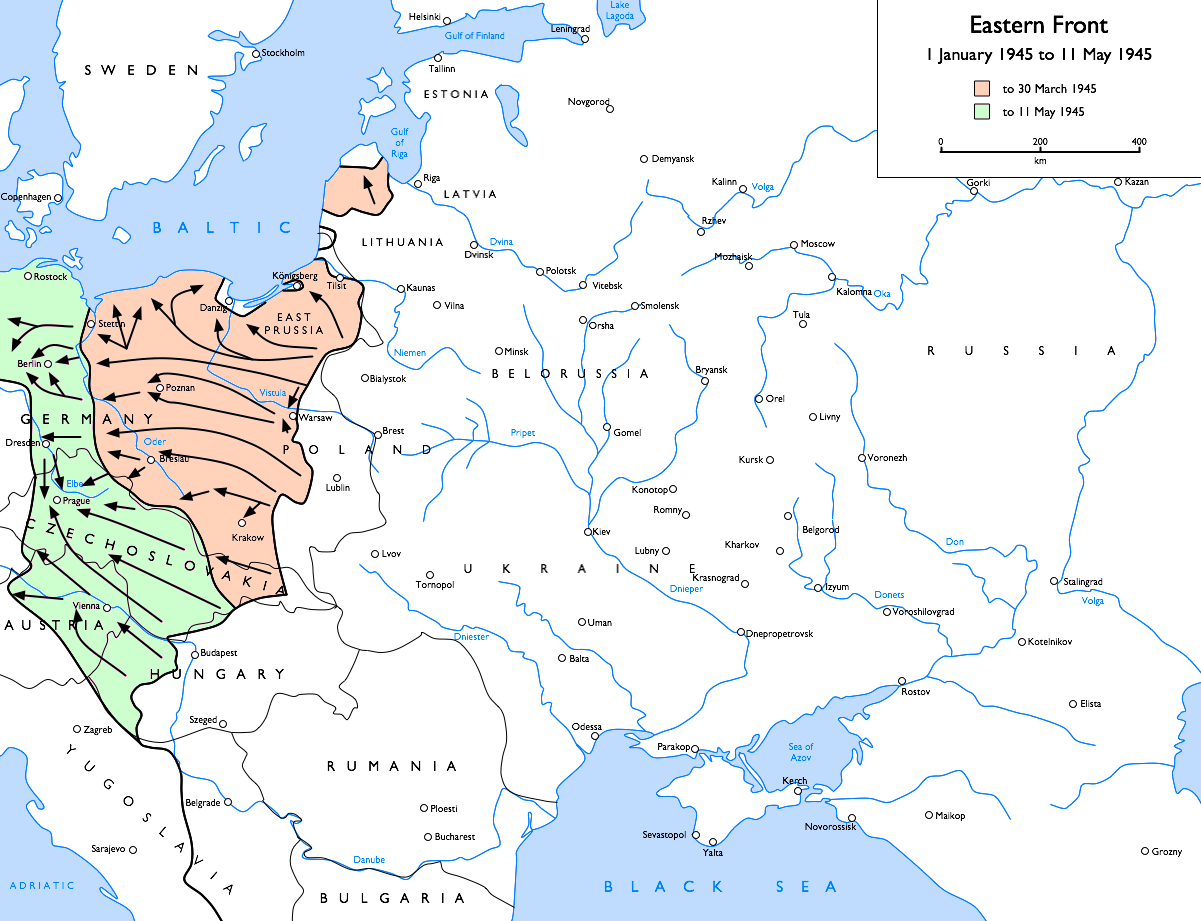 |
Above: Soviet advances on the Eastern Front, January 1 to May 11, 1945. The pink portion of the map represents advances to March 30, 1945; green to May 11, 1945.
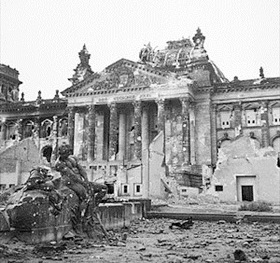 | 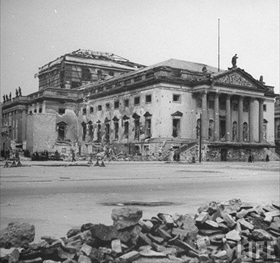 |
Left: The German Reichstag shows the scars of battle in mid-1945. The Reichstag had not been restored by the Nazis since the 1933 fire that gutted the interior, but the Soviets considered it a prime target in the Battle of Berlin (April 23 to May 2, 1945), and artillery and tank fire each took its toll on the building.
![]()
Right: The Staatsoper Unter den Linden (Berlin State Opera) was bombed in early 1941 but reopened in mid-December, only to close again in August 1944 when the Gauleiter of Berlin, Joseph Goebbels (also Propaganda Minister), closed down Berlin and the rest of Germany in the name of “Total War.” The Staatsoper was once again destroyed on February 3, 1945, in a ferocious daylight raid that left much of Berlin’s city center in ruins. However, it was left to Soviet heavy artillery in April 1945 to reduce the capital of Hitler’s Thousand-Year Reich to a mass of rubble.
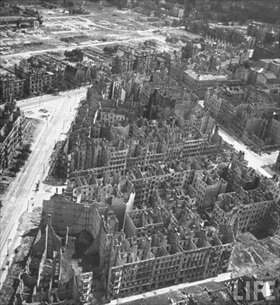 | 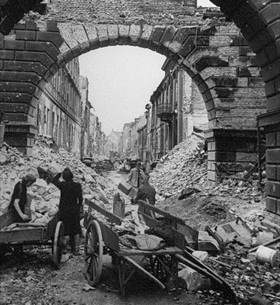 |
Left: An aerial photo of Berlin shows the legacy of destruction left by the war. By April 1945 Berlin had become a moonscape of ruined buildings and cratered streets.
![]()
Right: A Danish journalist, Paul von Stemann, remembered the end days of Berlin as a time of “dullness, anticipation, fear and continuous bombing. . . The war seemed perpetual. . . The flowers had gone, the books had been burnt, the pictures had been removed, the trees had been broken, there were no birds singing, no dogs barking, no children shrieking . . . there was no laughter and no giggling. . . [The sky] was often effaced by the stinking and greasy carpets of voluminous black smoke.” Quoted in Moorhouse, Berlin at War, pp. 346–47.
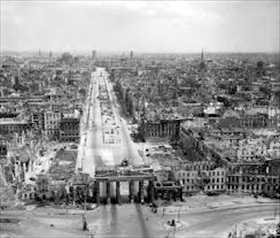 | 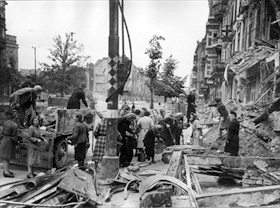 |
Left: Berlin’s premier street Unter den Linden in 1945 presented a grim contrast with the street’s prewar splendor. View is to the east.
![]()
Right: Berliners had learned to clear streets following Allied bombing raids in the early days of the war. During the Battle in Berlin, many streets and sidewalks were turned into rubble-fields and thousands of citizens were conscripted afterwards to make them passable.
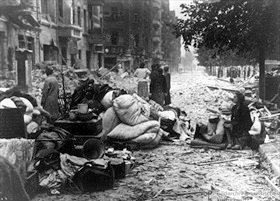 | 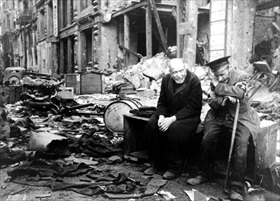 |
Above: Homeless Berliners survey their destroyed homes, while two elderly men sitting amid the street rubble may be contemplating their future in post-Nazi Germany.
Burt Lancaster Narrates Account of Soviet Offensive to Liberate Poland, January 1945
![]()

 History buffs, there is good news! The Daily Chronicles of World War II is now available as an ebook for $4.99 on Amazon.com. Containing a year’s worth of dated entries from this website, the ebook brings the story of this tumultuous era to life in a compelling, authoritative, and succinct manner. Featuring inventive navigation aids, the ebook enables readers to instantly move forward or backward by month and date to different dated entries. Simple and elegant! Click
History buffs, there is good news! The Daily Chronicles of World War II is now available as an ebook for $4.99 on Amazon.com. Containing a year’s worth of dated entries from this website, the ebook brings the story of this tumultuous era to life in a compelling, authoritative, and succinct manner. Featuring inventive navigation aids, the ebook enables readers to instantly move forward or backward by month and date to different dated entries. Simple and elegant! Click 











